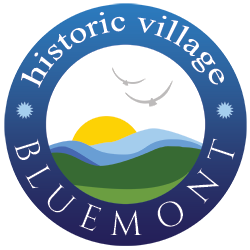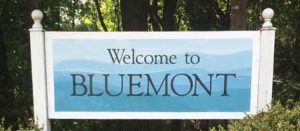Bluemont, Virginia is a bucolic village located just off Route 7, and forms one of six Historic and Cultural Conservation Districts in Loudoun County.
Our village contains a mixture of lovely old homes, historic buildings, former schoolhouses (three!), and a number of active businesses. The surrounding neighborhood stretches across the crest of the Blue Ridge (including a length of the Appalachian Trail) and down to the Shenandoah River.
A large portion of the village lies in the Bluemont Historic District. It has been listed on both the Virginia Department of Historic Resources – Virginia Landmarks Register (1/17/84) and the United States National Park Service – National Register of Historic Places (2/23/84). View the nomination form.
Jean Herron Smith and Evelyn Porterfield Johnson wrote about our history in From Snickersville To Bluemont: The Biography and History of A Virginia Village (for sale during our annual Fair at the E.E. Lake Store):
In 1769, the land on which our village lies was conveyed to John Augustine Washington, half-brother of George Washington, from George Carter who had received a land patent from Lord Fairfax. Washington, in turn, conveyed 624 acres to Edward Snickers. Snickers sold to Richard Wistar of Philadelphia in 1777, and Wistar sold to William Clayton, whose son, Amos Clayton, built splendid Clayton Hall at the side of the Snickersville Turnpike in 1797.
In 1807, when Snickers operated a ferry across the Shenandoah River, the area was called Snickers Gap. The settlement became known as Snickersville as an act of the Virginia General Assembly in 1826. In 1853, Snickersville contained “fifteen dwelling houses, one house of public worship, one common school, one Masonic hall, two factories, one tailor, one wagon maker, three blacksmiths, and one copper and tin plate worker.”
When the Civil War descended, a skirmish occurred right in the village when the Yankees, in search of some good home cooking, met up with a Confederate band. Then, in 1900, the Washington and Old Dominion Railroad extended its service to Snickersville. As part of its promotion of the town as a vacation resort at the foot of the Blue Ridge Mountains, the railroad initiated a name-change to Bluemont, capitalizing on the cool ridges away from the Washington heat.
Between 1900 and 1905, the E.E. Lake Store was built to accommodate an ice cream parlor, a general store, a barber shop, the post office, and a meeting and dance hall upstairs. Buggy rides transported visitors to Bear’s Den to view the valley. Drummers [travelling salesmen] took meals at Mrs. Weadon’s: fried chicken, country ham, fresh vegetables, hot rolls, pies, and buttermilk or sweet milk—all for 50 cents.
The Bluemont Citizens Association was organized in 1955 and the Fair in 1969 to celebrate these eras of our history. An industrious, innovative people, Bluemonters appreciate the contributions of those who found life close to idyllic here at the foot of the Blue Ridge.
Want to learn more? Visit the Bluemont Heritage website.

